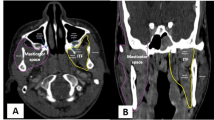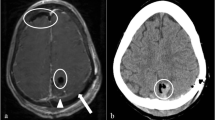Summary
Fourty-two consecutive patients with craniopharyngioma were treated by “stereotactic approach”, i.e. preferentially stereotactic puncture and installation of colloid isotope into cystic tumours and external stereotactic single dose irradiation to solid tumour parts. In a minority of cases, such treatment was less suitable, and surgical removal and/or radiotherapy was used. There was no peroperative mortality. A long-term follow up (observation time 10–23 years) of the 31 patients alive indicated that they were socially well adapted with a high rate of fulltime work and a low rate of intercurrent disease. In spite of substitution therapy for pituitary insufficiency in most cases, the patients were subjectively seldom disturbed by their disease.
Our results support a change in the choice of therapy for craniopharyngioma patients, from open neurosurgery to the less invasive stereotactic techniques.
Similar content being viewed by others
References
Amendola BE, Gebarski SS, Bermudez AG (1985) Analysis of treatment results in craniopharyngioma. J Clin Oncol 3: 252–258
Andler W, Roosen K, Clar HE (1979) Pre- and postoperative evaluation of hypothalamo-pituitary function in children with cranio-pharyngiomas. Acta Neurochir (Wien) 45: 287–299
Arem R, Zoghbi W, Chan L (1983) Amenorrhea-galactorrhea and craniopharyngioma. Surg Neurol 20: 109–112
Backlund E-O, Johansson L, Sarby B (1972) Studies on craniopharyngiomas II. Treatment by stereotaxis and radiosurgery. Acta Chir Scand 138: 749–759
Backlund E-O (1973a) Studies on craniopharyngiomas III. Stereotaxic treatment with intracystic yttrium-90. Acta Chir Scand 139: 237–247
Backlund E-O (1973b) Studies on craniopharyngiomas IV. Stereotaxic treatment with radiosurgery. Acta Chir Scand 139: 344–351
Backlund E-O, Axelsson B, Bergstrand C-G, Eriksson A-L, Norén G, Ribbesjö E, Rähn T, Schnell P-O, Tallstedt L, Sääf M, Thorén M (1989) Treatment of craniopharyngiomas—the stereotactic approach in a ten to twenty-three years perspective. I. Surgical, radiological and ophthalmological aspects. Acta Neurochir (Wien) 99: 11–19
Bloom HJG (1975) Combined modality therapy for intracranial tumors. Cancer 35: 111–120
Carmel PW, Antunes JL, Chang CH (1981) Craniopharyngiomas in children. Neurosurgery 11: 382–389
Cavazutti V, Fischer EG, Welch K, Belli JA, Winston KR (1983) Neurological and psychophysiological sequelae following treatment of craniopharyngioma in children. J Neurosurg 59: 409–417
Clopper RR, Meyer WJ, Udvarhelyi GB, Money J, Aarabi B, Mulvihill JJ, Piasio M (1977) Postsurgical IQ and behavioral data on twenty patients with a history of childhood craniopharyngioma. Psychoneuroendocrinol 2: 365–377
Danoff BF, Cowchock FS, Kramer S (1983) Childhood craniopharyngioma: survival, local control, endochrine and neurologic function following radiotherapy. Int J Radiat Oncol Biol Phys 9: 171–175
Fischer EG, Welch K, Belli AJet al (1985) Treatment of craniopharyngioma in children 1972–1981. J Neurosurg 62: 496–501
Flick TH, Michel M (1986) Rehabilitation jugendlicher Kraniopharyngeom-Patienten. Rehabilitation 25: 45–52
Franks S, Nabarro IDN, Jacobs HS (1977) Prevalence and presentation of hyperprolactinemia in patients with “functionless” pituitary tumours. Lancet i: 778–780
Galatzer A, Nofar E, Beit-Halachmi N, Aran O, Shalit M, Roitman A, Laron Z (1981) Intellectual and psychosocial functions in children, adolescents and young adults before and after operation for craniopharyngioma. Child Care Health Dev 7: 307–316
Galatzer A, Aran O, Beit-Halachmi N, Nofar E, Rubitchek J, Pertzelan A, Laron Z (1987) The impact of long-term therapy by a multi-disciplinary team on the education, occupation and marital status of growth hormone deficient patients after termination of therapy. Clin Endocrinol 27: 191–196
Grant DB, Lyen K (1982) Hypopituitarism after surgery for craniopharyngioma. Child's Brain 9: 201–204
Hoffman HJ, Hendrick EB, Humphreys RP, Buncic JR, Armstrong DL, Jenkin RDT (1977) Management of craniopharyngioma in children. J Neurosurg 47: 218–227
Hoffman HJ (1985) Craniopharyngiomas. Can J Neurol Sci 12: 348–352
Hoffman HJ (1987) Craniopharyngiomas. Prog Exp Tumor Res 30: 325–334
Kahn EA, Goscg HH, Seeger JF, Hicks SP (1973) Forty-five years of experience with the craniopharyngiomas. Surg Neurol 1: 5–12
Katz EL (1975) Late results of radical excision of craniopharyngiomas in children. J Neurosurg 42: 86–90
Keraly JL, Aubier F, Derome P, Kalifa CH, Lemerle J, Canlorbe P, Chaussain JL, Job JC (1986) Evolution à moyen terme des craniopharyngiomes de l'enfant en fonction des choix thérapeutiques initiaux. Arch Fr Pédiatr 43: 593–599
Kobayashi T, Kageyama N, Ohara K (1981) Internal irradiation for cystic craniopharyngioma. J Neurosurg 55: 896–903
Kuskowska-Wolk A, Rössner S (Submitted 1989) Prevalence of obesity in Sweden. Cross-sectional study of a representative adult population. Acta Med Scand
Lapras C, Patet JD, Mottolese C, Gharbi S, Lapras Ch (1987) Craniopharyngiomas in childhood: analysis of 42 cases. Prog Exp Tumor Res 30: 350–358
Leksell L, Lidén K (1952) A therapeutic trial with radioactive isotopes in cystic brain tumour. In: Radioisotope techniques. Vol 1, Medical and physiological applications, H. M. Stationery Office, Oxford, pp 1–4
Leksell L, Backlund E-O, Johansson L (1967) Treatment of craniopharyngiomas. Acta Chir Scand 133: 345–350
Lindqvist G (1966) Mental changes after transsphenoidal hypophysectomy. Acta Phys Scand 42: Supplement 190
Lundberg PO, Osterman PO, Wide L (1981) Serum prolactin in patients with hypothalamus and pituitary disorders. J Neurosurg 55: 194–199
Lyen KR, Grant DB (1982) Endocrine function, morbidity and mortality after surgery for craniopharyngioma. Arch Dis Child 57: 837–841
Matson DD (1964) Craniopharyngioma. Clin Neurosurg 10: 116–129
Matson DD, Crigler Jr JF (1969) Management of craniopharyngioma of childhood. J Neurosurg 30: 377–390
Mori K, Handa H, Murata T, Takeuchi T, Miwa S, Osaka K (1980) Results of treatment of craniopharyngioma. Childs Brain 6: 303–312
OECD: Employment Outlook September 1985
Petito CK, de Girolami U, Earle KM (1976) Craniopharyngiomas: a clinical and pathological review. Cancer 37: 1944–1952
Sveriges officiella Statistik. Statistiska Centralbyrån, Stockholm (1985). Trender och prognoser inför 90-talet
Shillito J (1986) Treatment of craniopharyngioma. Clin Neurosurg 33: 533–546
Sorva R, Heiskanen O (1986) Craniopharyngioma in Finland. A study of 123 cases. Acta Neurochir (Wien) 81: 85–89
Sorva R, Jääskinen J, Heiskanen O, Perheentupa J (1988) Postoperative computed tomographic control of 38 patients with craniopharyngioma. Surg Neurol 29: 115–119
Stahnke N, Grubel G, Lagenstein I, Willig RP (1984) Longterm follow-up of children with craniopharyngioma. Eur J Pediatr 142: 179–185
Stelling MW, McKay SE, Carr WA, Walsh JW, Baumann RJ (1986) Frontal lobe lesions and cognitive function in craniopharyngioma survivors. AJDC 140: 710–714
Svolos DG (1969) Craniopharyngiomas: a study based on 108 verified cases. Acta Chir Scand [Suppl] 403: 1–44
Sweet WG (1976) Radical surgical treatment of craniopharyngiomas. Clin Neurosurg 23: 52–79
Sweet WH (1980) Recurrent craniopharyngiomas: therapeutic alternatives. Clin Neurosurg 27: 206–229
Symon L, Sprich W (1985) Radical excision of craniopharyngioma. Results in 20 patients. J Neurosurg 62: 174–181
Thomsett MJ, Conte FA, Kaplan SL, Grumbach MM (1980) Endocrine and neurologic outcome in childhood craniopharyngioma: Review of effect of treatment in 42 patients. J Pediatr 97: 728–735
Author information
Authors and Affiliations
Rights and permissions
About this article
Cite this article
Sääf, M., Thorén, M., Bergstrand, C.G. et al. Treatment of craniopharyngiomas—the stereotactic approach in a ten to twenty-three years' perspective. Acta neurochir 99, 97–103 (1989). https://doi.org/10.1007/BF01402315
Issue Date:
DOI: https://doi.org/10.1007/BF01402315




